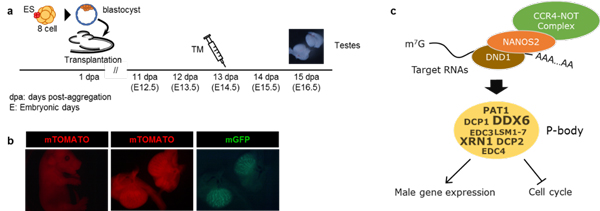Genetics without making mouse lines
Saga Group / Mammalian Development Laboratory
Division for development of genetic-engineered mouse resource
ES-mediated chimera analysis revealed requirement of DDX6 for NANOS2 localization and function in mouse germ cells
Ryuki Shimada, Makoto Kiso, Yumiko Saga
Scientific Report 9, Article number: 515 (2019) DOI:10.1038/s41598-018-36502-0
Mammalian Development/ Development of genetic-engineered mouse resource To analyze the function of genes in specific stage/tissue, Cre-loxp system is widely used in mouse. Cre-loxp system requires floxed genes and Cre recombinase which excise the flanked gene. To obtain such mouse, we need to cross the mouse for several times in a classical way. Here, we developed a new method to analyze the gene function in stage/tissue specific manner using chimera mouse. We established ES cells which contained germ cell specific inducible Cre and the reporter. Using this ES cells, we generated floxed-Ddx6 which is the important gene for RNA regulation. During male germ cell development, NANOS2 dependent RNA regulation is critical. Therefore, we asked whether DDX6 is required for the NANOS2 function using this developed chimera analysis. As a result, germ cell-specific Ddx6-KO resulted in the similar phenotype to NANOS2-KO mouse. This research enabled us to conduct the stage/tissue specific gene KO quickly and demonstrated the importance of cytosolic RNP granule in male germ cell development.
This research is partly supported by Grant-in-Aid for Scientific Research on Innovative Areas ”Epigenome dynamics and regulation in germ cells” and “Platform for Advanced Genome Science” to YS. Ryuki Shimada, the first author of this paper is a SOKENDAI student.

Figure: (a) Method for chimera- mediated cKO. (b) An example of chimera. Cre recombinase is activated by Tamoxifen injection only in germ cells (GFP-positive). (c) A model how NANOS2 regulate RNA metabolism. NANOS2-complex binds target RNA and may degrade RNA in P-bodies. DDX6 is required for P-body formation.















